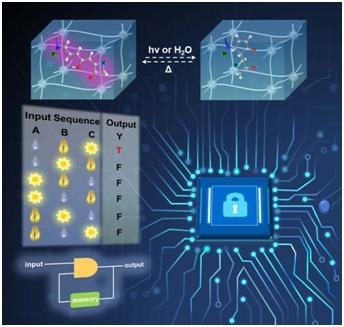Reviewed by Alex SmithNov 28 2022
Data encryption labels that are based on stimuli-responsive color-changing and luminescent molecules display excellent potential in cutting-edge information encryption and anticounterfeiting arenas due to seamless readout through the naked eye. Nevertheless, the smart materials’ response behavior is easy and predictable, making it simple for hackers to imitate or copy, which leads to forgery or information leakage.
 Schematic diagram of sequence logic encryption based on stimuli-responsive polymer gel. Image Credits: Prof. Huang’s group
Schematic diagram of sequence logic encryption based on stimuli-responsive polymer gel. Image Credits: Prof. Huang’s group
Sequential logic encryption (SLE) needs the terminal information’s recipient to key in the precise preset sequence keys. It prohibits trial-and-error attacks, which improves safety and facilitates wide applications in “end-to-end encryption” (E2EE). The SLE encryption scheme, however, has only been employed in digital circuits and has not been applied to responsive luminescent and photochromic molecules so far. This is likely because the requirement of logical response behavior is out of the reach of many responsive molecules.
The research team headed by Prof. Weiguo Huang from the Fujian Institute of Research on the Structure of Matter of the Chinese Academy of Sciences accomplished sequence logic data encryption and anticounterfeiting by harnessing molecular isomerization in polymer gels. This study was published in Science Advances.
By introducing negative photochromic molecules donor-acceptor Stenhouse adducts (DASAs) into polymer gels and by influencing the reversibility of response behavior through diamine conformational locking and substrate free-volume engineering, the scientists programmed and created a sequence of multi-responsive Gel-DASAs with controllable thermochromic, photochromic, and hydrochromic features.
They discovered that Gel-DASAs are manageably responsive to heat, light, and water stimuli, showing unforeseeable and varied responses and customized reversibility compared with conventional DASAs molecules. Hence, Gel-DASAs could be used to design high-end information encryption systems.
In addition, based on these smart materials, the research team applied an SLE advanced data encryption system. The system shows a memory function, which needs the preset sequence keys to decrypt the data.
The outcome of the DASA gel-based data-encryption system relies on both the present input stimulus and the sequence of previous inputs. The system will create fake data to mislead hackers upon entering incorrect sequences. Only one decryption chance was offered, and trial-and-error attacks were prohibited; therefore, the data encryption system’s security level improved.
This work offers a novel approach for putting stimuli-responsive materials into an advanced E2EE system using the SLE scheme.
Journal Reference:
Dong, Y., et al. (2022) Harnessing molecular isomerization in polymer gels for sequential logic encryption and anticounterfeiting. Science Advances. doi.org/10.1126/sciadv.add1980.